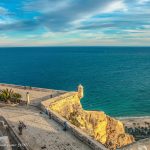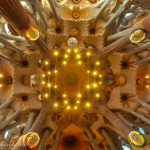-
 Guadix, a Spanish Hobbiton
An hour away from Granada, hidden between prehistoric karst mountains,( read more...)
Guadix, a Spanish Hobbiton
An hour away from Granada, hidden between prehistoric karst mountains,( read more...) -
 Alicante, Spain with a Nordic vibe
Alicante represents the door to the Southern vibes of Spain.( read more...)
Alicante, Spain with a Nordic vibe
Alicante represents the door to the Southern vibes of Spain.( read more...) -
 Tarragona, pure magic!
Arriving in Tarragona on the very first night of its( read more...)
Tarragona, pure magic!
Arriving in Tarragona on the very first night of its( read more...) -
 In the sacred woods of La Sagrada Familia
It is truly impossible to describe the feeling I had( read more...)
In the sacred woods of La Sagrada Familia
It is truly impossible to describe the feeling I had( read more...) -
 Venice, just a perfect day
Take a sunny day after the Christmas holidays when tourists( read more...)
Venice, just a perfect day
Take a sunny day after the Christmas holidays when tourists( read more...) -
 Northern Lights:The dance of the Green Spirits
For many years one of the most funny stories about( read more...)
Northern Lights:The dance of the Green Spirits
For many years one of the most funny stories about( read more...)
Today around 8pm a voice got spread that a pilot whale and a dolphin got caught and killed, somewhere 4 hour away by boat in the open sea by some local fishermen and hunters.
Together with my Greenlandic friends Naja and Suuluaraq we went to the harbour and found the two mammals laying already on the rocks. We jumped on the rocks to touch them while they cut a piece of meat to taste if it was good. After a while, the village started to show up, too to come and see the catch of the day, and men came to start working the meat.
Usually whales and dolphins are skinned. The skin and the fat just underneath, cut in slices, is considered a delicacy around here. People use to eat it raw, with the add of some herbs on it. They chew it like that, according to if it is tender or not.

The pilot whale, on the left, and the dolphin on the right, are sized and their skin is cut in slices
The meat gets shared with the entire village that eat it or store it for winter, while all the remaining become dog’s food. In the photo you can see their skin being sliced by the hunters who caught them. There was a seal that got killed as well. Seal for these people is the main resource of food. They don’t throw anything away from the seal.

Seal’s meat, the bloody one at the bottom of the picture, being cut in pieces. On the left you can see a local, with a plastic bag in his hand, waiting to get some of the animal’s remainings for his dog
They eat the meat, keep the skin to make clothes or for decorations, and give the rest to the dogs, once again. In the photo the seal, is the one that is being cut at the bottom of the picture full of blood.
When a whale gets killed, it becomes an even for the entire village. Kids surround the men working on the animal and often cut their own slice of skin and eat it. It is a completely different world dimensions. Once again, we need to try to look at this with different eyes. This for Greenlandic people is food, and it is their ancestors’ food, too. It means life. And it is part of the circle of life, that up here is very fragile. ”You cannot forbid us to eat the food of our Ancestors”, Inuits keep repeating, and they are right. This animals are killed for food, not for hunting games. Besides that, there are several laws protecting these animals. Hunters need to have a special licence to hunt these mammals, they can do it only in short periods of the year and only in some parts of the sea.
Today, while sitting at the harbor at sunset surrounded by locals busy in the most ancient of their activities, the one that has given them the possibility to survive centuries of history in the most extreme of all the planet’s weathers, and noticing that locals are starting to recognize me and treat me like a known face, I felt good and I remembered the reason we, actually, I travel.
Che giornata a Kulusuk!
Stasera verso le 8 si è sparsa la voce in giro che erano stati uccisi una balenottera e un delfino, da qualche parte in mare aperto a 4 ore di distanza in barca dal villaggio, da alcuni cacciatori del luogo. Insieme ai miei amici Inuit Naja e Suuluaraq siamo andati al porticciolo del villaggio a vedere e quando siamo arrivati i due mammiferi erano già stati deposti sulle rocce. Ne abbiamo approfittato per avvicinarci e toccarli, e loro hanno addirittura anche tagliato un pezzetto di carne per assaggiarlo.
Dopo un po’ la gente del villaggio ha iniziato ad arrivare mentre gli uomini hanno iniziato a mettersi al lavoro e a tagliare a pezzi gli animali.
Di solito la pelle le balenottere e i delfini viene tagliata a strisce. Queste strisce di pelle grasso sono considerate delle prelibatezze da queste parti. La gente le mangia crude, con delle spezie sopra per esaltarne l’aroma.
La carne invece viene fatta a pezzi e condivisa con l’intero villaggio, che la mangia o la conserva per l’inverno. La cucinano di solito bollita, alla maniera tradizionale, I barbecue da queste parti non sono visti di buon occhio e ai locali la carne arrostita di solito non piace, dicono che ha un sapore strano. In una terra che non ha legno perché priva di alberi, il fuoco, nei tempi antichi veniva fatto bruciando grasso di foca, che emanava un odore disgustoso e forte. Da qui si capisce come un concetto come il barbecue non è tipico in Groenlandia.
Anche i rimasugli dei due animali vengono divisi tra i locali che li danno ai cani come cibo.
C’era anche una foca sulle rocce del porto, che era stata uccisa qualche ora prima. La si vede in basso nelle foto, quella piena di sangue. La foca è il cibo tipico e tradizionale di questa gente. Ciò che li ha sfamati e continua a farlo da secoli. Non si butta via niente della foca, è un po’ come il nostro concetto di maiale. La carne viene cucinata, la pelliccia usata come decorazione o come vestiti per tenersi caldi in inverno, il restante dato ai cani come cibo e il grasso usato in molteplici altri modi.
Quando questi animali vengono catturati ed uccisi è un evento per l’intero villaggio. I bambini circondano gli uomini che tagliano a pezzi gli animali e a volte li si vede tagliarsi il loro piccolo pezzo di pelle da soli. Una dimensione infantile lontana anni luce dalla nostra.

Seal is the main resource of food for Inuit people. They use everything of it, and the remaining parts become dogs food.
Come gli inuit stessi ci insegnano, bisogna guardare questi avvenimenti con occhi diversi. Bisogna abbandonare i nostri principi pre stabiliti e occidentalizzati e vedere eventi come questo nel contesto in cui accadono. Qui uccidere questi animali ha a che fare con il ciclo della vita, con la sopravvivenza, ma anche con tradizioni millenarie, antiche. “Non potete proibirci di mangiare il cibo dei nostri antenati”, ripetono spesso gli inuit da queste parti, e a mio avviso hanno ragione.
La caccia a questi mammiferi è anche qui regolata da leggi severe, pochi possono farlo, e devono avere una licenza apposita, ed inoltre solo in alcuni punti del are aperto si può cacciare, e per di più non tutto l’anno. Ma soprattutto, la caccia a questi animali da queste parti significa cibo e non per sé stessi ma per tutta la comunità. Una balenottera forse sfama l’intero villaggio.
Oggi mentre ero seduta al porto tra la gente del luogo, che nel frattempo si è abituata alla mia presenza tra di loro, inizia a riconoscermi e a trattarmi come una del posto, mentre osservavo una delle attività più antiche di uno dei popoli più antiche della terra, mentre ero semplicemente là con loro a condividere un momento di felicità di questo popolo cos’ semplice e vivo, mi sono sentita bene. E felice. Viaggiare è anche questo, e ogi me ne sono ricordata ancora una volta.
Click on the image below and enjoy the full photo gallery!













